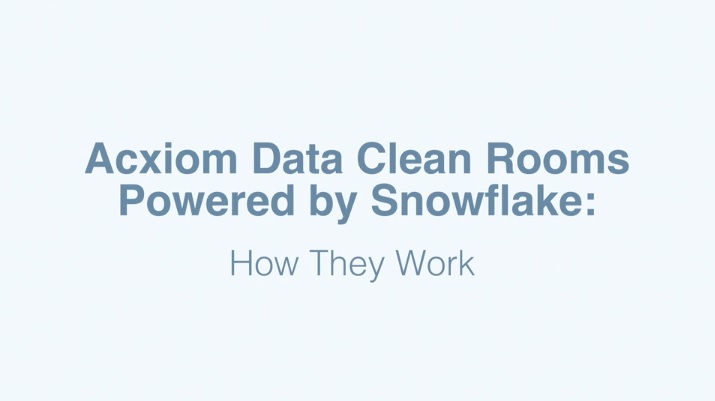What is second party data?
Generate powerful audience insights through privacy-conscious data partnerships
What is second-party data?
Second-party data refers to any first-party data that two or more organizations agree to share privately for their mutual benefit.
The value exchange in a second-party data arrangement is often strategic, i.e., sharing audience insights between organizations for better marketing, including prospecting and relationship building.
Second-party data partnerships often use a neutral intermediary, like Acxiom, to manage the data exchange in a privacy-conscious manner.
Participants in a second-party data relationship retain control over their own data and its usage. The second-party data created from the participating organizations can only be used in a carefully prescribed manner – it doesn’t confer ownership.
Zero-party data
Data intentionally and proactively shared with an organization by a customer such as a poll or a survey (often in return for discounts or other benefits).
First-party data
Data collected directly by a company about its customers’ interactions and transactions on its platforms and services.
Second-party data
Data that is ethically and legally shared between two companies, often under a partnership agreement, for their mutual benefit.
Third-party data
Data about people ethically sourced from data providers, advertisers, or other external third parties that have no direct relationship with the people.
See also:
What’s in it for you? Why should you consider second-party data?
There are many major benefits to encourage brands to use second-party data or enter into second-party data partnerships. Second-party data enables organizations to:
- Enrich their data sets with up-to-date, high-quality data from carefully selected data partners.
- Activate new, relevant, and valuable audiences beyond the reach of their own first-party data.
- Connect with fresh audience data potentially not available from third-party data providers.
- Access deeper insights into their audience’s preferences, interests, and buyer behaviors.
- Segment audiences with more granularity and provide more personalized customer engagement.
- Test new segmentations and validate lookalike audiences with fewer online impressions – therefore at a lower cost.
- Form valuable, ongoing data partnerships with other brands – providing the opportunity for future co-marketing and joint data collaborations.
Second-party data examples
Because second-party data is essentially a partner’s first-party data, it includes any audience information collected directly by that partner across its various platforms and services. This can include:
- Audience actions, behaviors, and intent data, e.g., actions taken across a website, app, platform, or product set that provide clues into the degree of interest a customer or prospect may have in a product or service
- Basic contact data, e.g., name, address, phone number or email address
- Customer purchase history, e.g., what, where, when, at what price, in what style
- Demographic information, e.g., age, gender, race, income, or marital status
- Social media interactions, e.g., audience comments and conversations
- Subscription-based interactions or product info, e.g., services or items customers request, and often pay for, on a regular basis. Examples include email newsletters and subscription-based products.
As with first-party data, if information shared via a second-party partnership includes personally identifiable information (PII) there are strict consent-based regulations that must be adhered to – such as the California Consumer Privacy Act (CCPA) or the General Data Protection Regulation (GDPR).
- See also:

How is second-party data used?
Second-party data starts life as first-party data from trusted sources. As a result, second-party data tends to be both highly accurate and – if second-party data partners are carefully vetted – highly relevant.
But the practical significance of second-party data is less what it is, and more what it enables a brand to achieve. Having highlighted some of the key second-party data benefits above, here’s further detail on some common use cases:
Gain greater audience insights to deliver more personalized marketing
Increasingly important as we head toward the post-cookie era, second-party data uses partner data to get a more complete, layered, and nuanced understanding of a brand’s customer base. Additional insights into the audience’s preferences, intent, behaviors, and interactions enable more personalized content, a more tailored approach to customer experience, and enhanced opportunities for audience segmentation.
Build audience extensions
At its most simple, second-party data enables marketers to increase campaign reach significantly by engaging with strategically selected customers of other strategically selected brands. This is also particularly valuable for businesses that have fewer one-to-one connections with their end users (and so less first-party data), for example, a consumer packaged goods (CPG) brand that sells primarily via third parties.
Create lookalike audiences
By analyzing the common characteristics and behaviors of their highest lifetime value customers, brands can identify key profile attributes to model and build lookalike audiences from their second-party data partners’ customer bases.
Form strategic partnerships and co-marketing opportunities
A tried and trusted means of maximizing ROI with second-party data comes when brands providing connected or adjacent services create strategic data partnerships. For example, joint marketing or loyalty campaigns are created by uniting the data of airlines, hotels, and rental car companies – each brand’s customers have a defined overlapping interest.
Industries benefiting from second-party data
Wherever there are complementary business objectives between organizations, no matter the industry, there is the potential for successful second-party data collaborations. Check out these examples of second-party data usage:
- Retail & CPG: Retailers collect vast quantities of first-party data whereas consumer packaged goods companies tend to have less direct customer interaction. Second-party data partnerships give CPGs greater insight into buyer behaviors and promotional effectiveness.
- Travel: This industry has multiple, overlapping opportunities for second-party data collaborations. Airlines, for example, can partner with hotels, rental car companies, travel agencies, and even credit card companies to optimize the travel experience and reach new but closely connected customer groups.
- Media: Publishers and media network owners collect a wealth of segmented lifestyle and demographic customer data points that intersect with multiple other industries – CPG could mine insights into consumer behavior, content preferences, and engagement patterns, for example.
- Financial services: By partnering with insurance firms, banks not only open up cross-selling opportunities, they can also share insights into consumer behaviors and risk potential.
- Telcos: Organizations like mobile carriers can combine insights with streaming services to enhance their understanding of consumer viewing habits, content preferences, and streaming behavior, enabling more targeted marketing strategies.
Acquiring and sharing second-party data
There are several ways for an organization to acquire and share second-party data, from a direct approach to purchase information from businesses with desirable data sets to data marketplaces.
However, such methods can place the onus of data security and compliance with tight data privacy regulations on the purchaser. An increasingly popular option for second-party data collaboration is the data clean room.
What is a data clean room?
Data clean rooms (DCRs) provide a safe, cloud-based neutral zone for two or more organizations to ethically share aggregated and anonymized customer data – without exposing sensitive personally identifiable information (PII).
With DCRs there is little or no data transfer, and a brand’s customer information never leaves its own environment, meaning data sovereignty is assured. Within the safe space of the DCR, data partners simply share agreed access to specific elements of audience information, then disable sharing on completion. All brands retain full control of their data at all times.
A DCR is a powerful data management platform that also enables:
- Co-branding/co-marketing opportunity analysis: Assess the value of potential partnerships for increasing engagement and revenue.
- Neutral third-party measurement: Use the DCR environment to measure omnichannel digital marketing performance, by combining first-party data with publishers’ exposure to test audience engagement.
- Loyalty opportunities: Use the data clean room to analyze (and ultimately share data with) complementary brands for potential integration into loyalty programs.
- Audience creation and activation. Second-party data partners use each other’s first-party data to create new audiences and enrich their own customer understanding to activate and measure more tailored engagements across channels.
Discover how Acxiom data clean rooms work
Acxiom provides a wide range of clean room solutions, helping brands maximize the power of their data. Learn more about how our data clean rooms work through this short video.

Partnerships and second-party data
Before entering into a second-party data partnership you need to do your research. A thorough review of prospective data partners is essential. A thorough second-party data validation process is equally essential.
This is how to ensure neither time nor money is wasted on unsuitable data collaborations. It also helps protect you against potential damage to your brand’s reputation, as well as protecting your customer relationships by ensuring your partners are only using ethical data protocols.
Here’s a checklist to help you select the right second-party data partner:
- Partner reputation: Seek clear evidence of previous data partnership success, including testimonials, as well as compliance with data privacy regulations.
- Data provenance: It’s crucial to trust where the data is coming from. Reputable data partners will be happy to provide source verification, along with their data collection and security processes. Anything less than transparency is a red flag.
- Data quality: Second-party data validation should prioritize verification of accuracy, usefulness, and completeness. If possible, obtain data samples from the second-party provider to check for missing or incomplete customer data. Use these samples to manually validate a selection of data records for accuracy. Where there is data overlap between your first-party data and their second-party data, look for and validate any discrepancies.
- Data management: Ensure the data provider has defined auditing processes for keeping customer records up-to-date; for example, are they using an enterprise identity solution?
Second-party data consent and governance
Before entering into a data partnership with other brands, it’s important to:
- Inform your customers about potential plans to share their data.
- Provide customers with the means to opt out
- Let customers know they may be engaged by selected partner brands.
- Ensure sensitive PII is anonymized when information is shared.
See also: To Build Lasting Customer Relationships, We Need To Get Serious About Privacy







